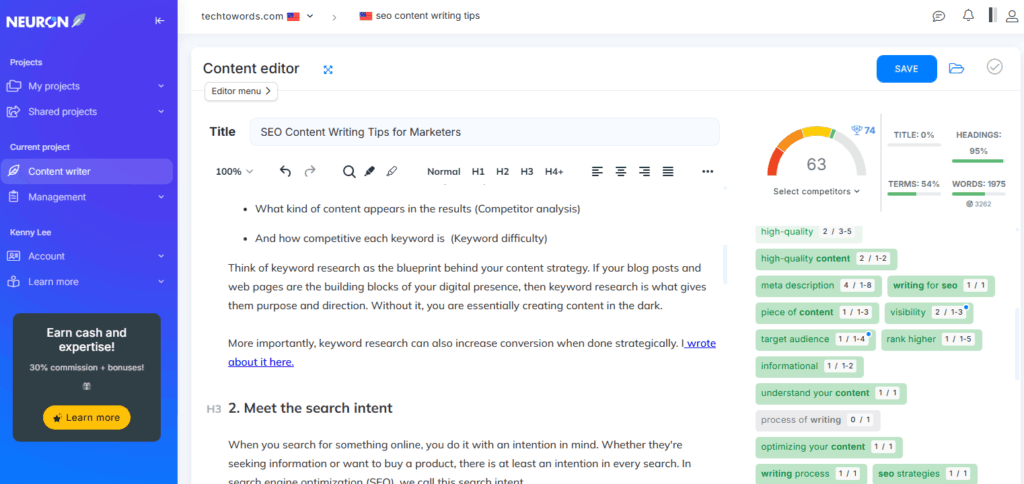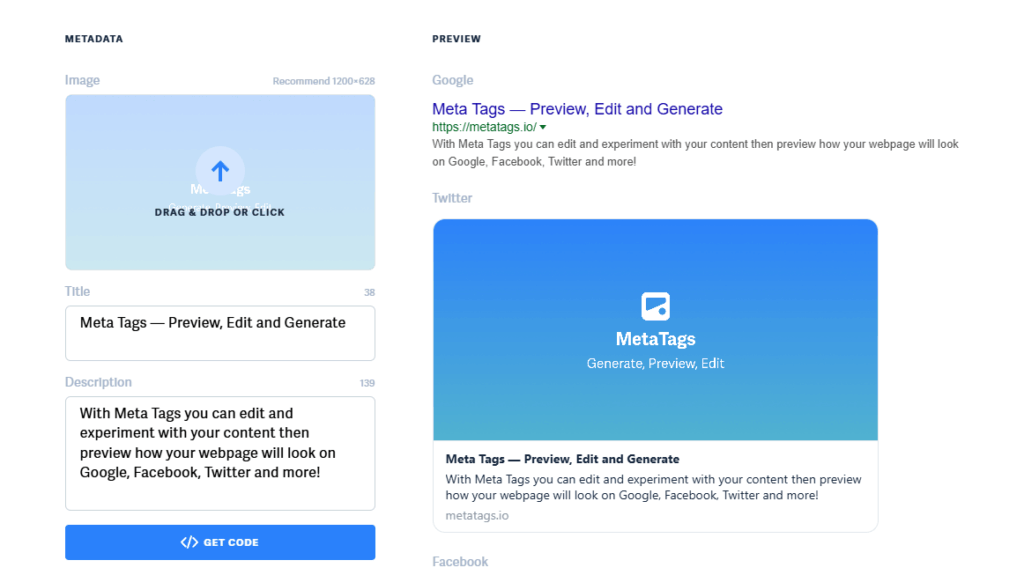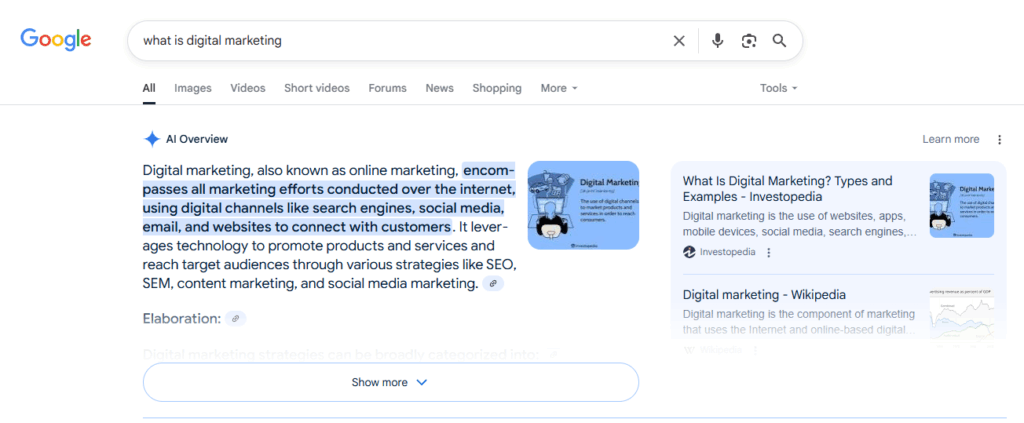SEO content writing is more than just plugging keywords into a blog post. Instead, it boosts visibility, attracts qualified traffic, and supports your overall marketing goals.
Whether you’re leading a team of content writers or working with freelancers, knowing the fundamentals can help you create SEO-friendly content.
But with so much information out there, it’s easy for content teams to focus on the wrong things: keyword density over intent, rankings over relevance, or worse — writing just for algorithms.
If you are unsure where to begin, don’t worry as I have got you covered. With 10 years of SEO writing experience for global brands, I know what works and what doesn’t when writing for search engines like Google.
Let’s start.
SEO writing tips for search visibility (and conversion)
When you shift your focus from the machine to the people, you can make your content loved by humans and search engines. I put these tips together to help you craft content that actually ranks on Google.
1. Keyword research
Keyword research is all about discovering the words and phrases people commonly type into search engines. It helps brands like yours understand what the target audience is actively searching for. This way, you can create high-quality content that aligns with those interests and search intents.

Basically, you need to step into the shoes of your ideal customer. Then, find out how they phrase their queries, what topics they care about, and how frequently they search for them. It is not just about the keywords themselves – that is one small part of the equation, but involves:
- How often are those terms searched (Volume)
- What kind of content appears in the results (Competitor analysis)
- And how competitive each keyword is (Keyword difficulty)
Think of keyword research as the blueprint behind your content strategy. If your blog posts and web pages are the building blocks of your digital presence, then keyword research is what gives them purpose and direction. Without it, you are essentially creating content in the dark.
More importantly, keyword research can also increase conversion when done strategically. I wrote about it here.
2. Meet the search intent
When you search for something online, you do it with an intention in mind. Whether they’re seeking information or want to buy a product, there is at least an intention in every search. In search engine optimization (SEO), we call this search intent.
To rank on Google, your content needs to match that intent. If someone is searching “how to start a YouTube channel,”, they probably want a step-by-step guide and not a masterclass on video editing.
Before your SEO writer types a single word, look at the top-ranking pages for your target keyword. What kind of content do they offer? This will give you clues on what readers expect out of your content.

Alternatively, use AI tools like ChatGPT to analyze the search intent for specific keywords. Just prompt the chatbot, “What is the search intent of [keyword]” and analyze the response.
3. Write for the audience.
The golden rule of marketing and writing for SEO is simple: know your audience. It is not just about gathering data; it is about truly understanding the people behind the numbers. You need to connect with them on a deeper level, empathize with their challenges, and provide clear answers to the questions they ask.
This is not the time to flaunt your A+ on your English test or show off an advanced vocabulary. Instead, focus on delivering information in the language and style your audience speaks.
For example, when you write for machine learning engineers, you use technical terms like ‘generative pretrained transformer’. But for non-tech readers, they can relate better when you describe technologies like ‘ChatGPT’ or ‘AI software’.
Tip: Sometimes, using jargon is inevitable when writing for non-tech readers, but do briefly explain what they mean when you introduce them.
4. Structure the article
Most readers won’t read your article word by word, especially if they are looking for a quick solution. The more scannable it is, the more likely it is to engage readers and perform well in search engine rankings.
Start by organizing your content with clear, keyword-focused subheadings. These act as signposts for both your readers and search engines, making it easier to find relevant information and understand the overall topic.
To improve readability even further, include elements like :
- bullet points
- lists
- highlighted quotes
These break up the text and draw attention to the most important takeaways at a glance.
Also, keep in mind that 95.9% of internet users worldwide access the web through their mobile phones. That’s why it’s crucial to check how your article appears on mobile devices. Make sure it’s easy to read, well-formatted, and loads quickly to stand a chance of ranking on Google.
5. Use keywords strategically
Although great content is written for people, keywords are still important for search engines to understand the underlying context. Once you have identified which keyword to use, sprinkle it naturally throughout your content. Include them in the:
- title
- at least one subheading
- the first paragraph
- and near the end of the article
But don’t over-sprinkle your keywords, or commit what SEOs call ‘keyword stuffing’.
Keyword stuffing is the practice of repeating the same word or phrase too many times. This can hurt your ranking and make your writing sound awkward. Just write normally and use your keyword when it is appropriate to do so.
Also, consider using related keywords or synonyms. This helps Google or other search engines understand the context of your content.

Tip: Optimizing keywords manually can be very laborious. These days, you can use tools like SurferSEO or NeuronWriter to make sure you cover the important keywords.
6. Include internal and external links
Links are important for both your readers and search engines. Internal links connect your article to other pages on your site. They help you direct readers to other information that might be helpful to them. For SEO, internal links are an underrated but one of the most effective SEO strategies to rank higher.
External links, meanwhile, point to other sources that are “outside” of your website. These add credibility and can back up your points. For example, you quote statistics from a research study and link to the original publication. Don’t be afraid to link to other websites – just make sure these websites are trustworthy.
7. Create high-quality content
No amount of SEO sorcery can save weak and useless web content. Your article needs to be useful, accurate, and well-researched. Otherwise, what’s the point of ranking on Google if the audience doesn’t understand your content?
So, double-check, no, triple-check your facts. Make sure your information is up-to-date. Don’t provide tips that merely scratch the surface; go beyond it! Add depth, explain why something matters, and include real-life examples to show it in action.
Remember that Google’s search algorithm favors content created with EEAT in mind. Here’s a glance of what EEAT means.
- Experience: You have personally done or gone through what you are writing about. You have been there, done that, and as such, you speak from experience.
- Expertise: You know your stuff on a deeper level. Your knowledge is accurate and helpful.
- Authoritativeness: Others see you (or your site) as a go-to source in your field.
- Trustworthiness: Your content is honest, transparent, and reliable. As a result, people trust you and your content.
8. Use media
A chunk or a block of text can sometimes feel overwhelming. You feel like there is just too much to read, and you don’t know where to focus. That’s when visuals come in – they can make the content you write more engaging and easier to understand.
Including images, charts, graphs, and infographics can help to drive your point home. For example, if you are showing data, include a table. If you are walking through steps, consider adding screenshots. Just make sure all visuals are relevant and don’t slow down your page in any way.
9. Write a strong meta title and description
Meta title its what people see in search engine results. It’s like a mini-ad for your article, so make the meta title count. Meanwhile, meta description summarizes the content that you wrote. While meta description is not a direct ranking factor for SEO, it can impact user engagement and click-through rates.
- The meta title should include your main keyword and clearly tell the reader what the article is about. Keep it short and concise – under 60 characters so it doesn’t get cut off.
- The meta description is a short summary (under 160 characters) that encourages clicks. Give people a reason to read your post. If you have ever watched Shark Tank, then just think of the meta description as a sort of pitch.
You can use meta.io to preview how your meta tags look on Google and other platforms. (It’s free)

10. Optimize for AI Overview and Featured Snippet
Google AI Overview (AIO) is the new prime spot for brand visibility. It uses generative AI to summarize responses for searches, especially for informational queries. According to a study, smaller websites not ranking in the top 10 of the search results can show up in AIO.

If you want a piece of content to be cited by AIO, focus on clarity, direct answers, and formatting that is easy for machines (and humans) to read. Of course, your content needs to rank for the search term before you stand a chance to be cited.
Beneath AI is featured snippet, which until recently, was considered position zero on Google, before AIO came. Unlike AIO, it extracts a part of the content from your web page and displays it in the coveted spot.
To increase your chances of landing a spot on the featured snippet.
- Include clear and concise FAQs.
- Use lists or tables for steps and comparisons.
- Use H2 or H3 headings with the question as the title.
11. Use SEO tools
You don’t have to do everything manually. There are many tools out there that can make good SEO writing easier, especially when you are still learning the ropes.
Tools like Surfer SEO and NeuronWriter help you optimize your content by showing you which keywords to include, how long your post should be, and what competitors in your field are doing.
If you’re not a professional writer, you can use AI writers like WriteSonic or Jasper to write. That said, remember to humanize the AI-generated content with stories, case studies, stats, and other insights. Otherwise, it’s very hard to rank plain AI content on Google.
Personally, I use these tools to guide my writing, not to replace my voice or creativity. They are like training wheels while you are getting the hang of things.
Final thoughts
SEO content writing isn’t about tricking Google into letting your content appear on the first page. But rather, it is about helping people and doing it in a way that search engines understand.
I hope you found the SEO content writing tips I share useful. Remember that creating great, optimized content for search takes time and practice.
Start with your reader in mind. Use keywords naturally. Write with clarity and flow in mind. And don’t worry if it is not perfect right away.
If you need help in creating SEO content that ranks, drop us a message.
FAQ
What is SEO in content writing?
SEO in content writing means creating articles, blog posts or web pages that are optimized to rank well in search engines. It involves using the right keywords, structuring content properly and making it useful to whoever is reading it.
How do I start SEO content writing?
Start by learning the basics of keyword research, writing clearly for your audience, and structuring your content well. Use free tools like Google Keyword Planner or Ubersuggest, and practice writing articles that answer common questions in your niche.
How to find keywords for SEO?
There are multiple tools you can use to find keywords for SEO. Tools such as Semrush, Ahrefs, Ubersuggest, or Google Keyword Planner can be used to discover what people are searching for. Look for terms with good search volume and manageable competition, and always consider what your audience is actually trying to find – in other words, their search intent.

